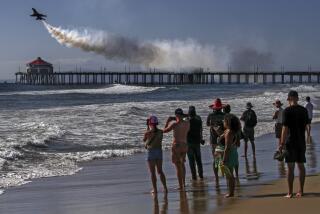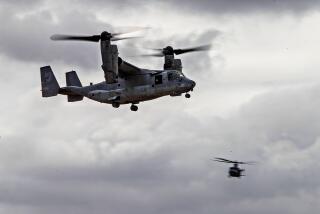S.D. Cancels 1990 Air Show at Brown Field After Audit
- Share via
SAN DIEGO — The City Council has canceled the 1990 Air/Space America show at Brown Field, citing an auditor’s prediction that its organizers would owe creditors nearly $5 million even if they staged a successful show next year, city officials said Wednesday.
Councilman Bruce Henderson announced the unanimous decision, reached in closed session Tuesday, during a Wednesday meeting of the council’s Public Facilities and Recreation Committee.
Besides revoking Air/Space America’s permit to use any city-owned airstrip, the council voted to withdraw the $300,000 in hotel tax funds that it was prepared to spend on the show, Henderson said.
Other Cities Considered
Bill Walsh, president of Air/Space America, expressed disappointment at the decision but predicted he will reach agreement within 45 days to stage the show in Palmdale, Calif., or Ft. Worth, Tex.
“I’m disappointed and somewhat shocked by the manner and time in which it occurred,” Walsh said. “We’ve been working with the city . . . trying to please them and make them happy, because it would obviously be easier to put that ’90 show on in San Diego.”
But Henderson made it clear that the council has lost confidence in Air/Space America’s ability to operate a successful show in 1990. According to two separate audits, organizers of the aerial extravaganza and trade show now owe creditors more than $4 million. They have yet to pay for an estimated $100,000 in damage to Brown Field from the May, 1988, show or hand over a $100,000 rent payment owed the city.
Organized by former San Diego Congressman Bob Wilson and by Walsh, a retired rear admiral, Air/Space America was envisioned as a biennial event designed to be America’s answer to the Paris air show. The idea attracted support from well-known figures such as Sen. Barry Goldwater and former astronaut Wally Schirra.
About 200,000 people attended the first Air/Space America show, in 1988, which included trade booths, paratroop jumps, aerial acrobatics, $985 rides on the supersonic jet Concorde and tours of the Soviet Union’s AH-124 transport, the world’s biggest aircraft. The attendance was about half what Walsh had predicted.
“It was just a situation where we didn’t have confidence in their business management, that we would be throwing good money after bad,” said Councilman Bob Filner, whose district includes Brown Field.
Concern About Other Shows
Henderson said the council also became concerned that Air/Space America might stage subsequent shows in other cities, causing the council to wonder whether its investment would pay off.
Frank Panarisi, director of consulting services for the auditing firm Deloitte, Haskins & Sells, which was hired by the city, projected that the 1990 air show would lose about $600,000, a figure that would be added to Air/Space America’s current $4.2-million debt.
“Our projections show that they would not quite break even for the 1990 show, and they would not even be able to pay for the debt” from the 1988 show, Panarisi said.
Walsh disputed both the calculation of the current debt and the predictions for 1990, saying his organization owes about $2.9 million to more than 2 dozen creditors but would pay that off and end the 1990 show about $400,000 in the black.
A city audit of Air/Space America’s finances as of Sept. 30 shows that the group is $4.45 million in debt, which includes more than $1 million owed to Evergreen Chemical Products for applying a polymer to Brown Field soil that was designed to take the place of more expensive asphalt. Walsh and city officials claim the polymer was a complete failure, and Walsh is refusing to pay the company.
At least eight firms have sued Air/Space America in an attempt to recoup payments, and nine have asked the city to pay them a total of $1.4 million in debts.
A major part of the financial snafu stems from a 1987 City Council decision to waive a requirement that Air/Space America obtain a construction bond that normally would be used to pay off creditors in the event of financial problems. According to Filner, who was not on the council at the time, city staff members warned the council about the possibility of financial problems in several reports before the decision.
Several of the contractors attended Wednesday’s council committee meeting and huddled privately with city lawyers afterward in the hope of determining their chances of recouping some money.
“We feel that Air/Space America, the city and the contractors are all partners in this thing, whether we want to be or not,” said Bob Spellman, managing partner of Rock Paving and Grading, which claims it is owed more than $49,000.
“They’ve gotten some debts. The only way those debts can be paid is if they have another show, so far as I know,” Spellman said.
Nearly nine months after the May air show, Brown Field operators are still repairing damage caused by the event, which Mike Tussey, airport operation manager, estimated will total $100,000.
More than $8,000 was spent to repair a hole in the main runway that was created when the giant Soviet transport made a quick turn and came to a halt, Tussey said. Replacing the main road to the control tower, necessitated by the failure of the polymer substance to harden into a usable surface, cost nearly $15,000.
Repairing a similar problem involving 41,000 square feet of space leased by the Experimental Aircraft Assn. will cost $18,000. And repairs to 70 lights torn off one of the taxiways will cost $6,000, Tussey said.
Although Walsh said that Air/Space America hoped to receive a rent credit for installing a $550,000 underground drainage system, Filner claimed that the system actually increases the chances of flooding.
“Everything they did, in fact, screwed up things more,” he said.
Besides its financial and permit woes, Air/Space America now faces possible competition from a Canadian group that hopes to stage an international air show near Vancouver in May.
The show, which has secured more than $3 million from the Canadian and British Columbian governments, is billed as “North America’s Premier Aerospace Trade Show and Symposium.”
“Airshow Canada is funded by the government to pay for things like promotion and marketing,” according to show spokesman Mark Pond. “That’s the key difference between us and San Diego.
“Funds exist for this show, and there won’t be checks bounced. I heard very uncomplimentary things about the San Diego Air Show.”
Times staff writer Greg Johnson contributed to this report.
More to Read
Sign up for Essential California
The most important California stories and recommendations in your inbox every morning.
You may occasionally receive promotional content from the Los Angeles Times.













